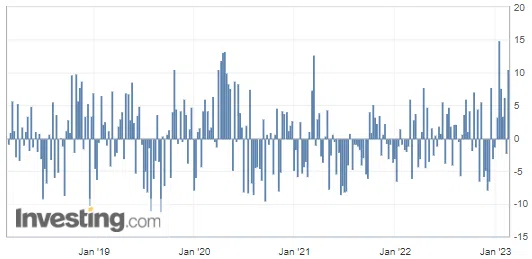Oil Declines on Expected U.S. Crude Accumulation
What is pulling crude oil prices down?
Oil prices fell further on Wednesday after the surprise decision by the US government to release millions of additional barrels from its strategic petroleum reserve (SPR) and because of a possible accumulation of crude inventories in the United States.
On Monday, the US government said it was going to put 26 million barrels of its strategic reserves on sale to comply with a law passed in Congress almost ten years ago.
The US administration was initially hesitant to do so given that 180 million barrels had already been released from the SPR last year. However, it was probably Russia's announcement last week that it would cut oil production by half a million barrels per day in March that prompted the US government to change its mind.
If this decision was able to surprise the energy markets, it is above all because the United States had given itself earlier commitments to replenish its reserves.
So, all of this, combined with mounting supplies – as per the last American Petroleum Institute (API) report that came up yesterday – is pulling crude oil prices down.
U.S. API Weekly Crude Oil Stock


On Tuesday evening, API estimated that crude inventories increased by 10.51 million barrels last week and gasoline inventories increased by 846,000 barrels:
United States API Gasoline Stocks

Charting & Analysis

On a macroeconomic level, the US dollar index (DXY/USDX) has rebounded just above the $100 mark ($100.820, to be precise) to reach the upper band of its regression channel. The level to be monitored is 105.631 (its previous swing high), as a breakout above that could display stronger bullish enthusiasm. The second scenario would be a return to the lower band of its regression channel, which would clearly trigger some buying pressure around the quarterly pivot acting as a support (S1) as well as the strong $100 psychological mark.
On the stock market, equities were also closing lower yesterday following the US yearly inflation figure that came out at 6.4% (versus the 6.2% expected), as investors were getting prepared for another tightening action on the Fed’s monetary policy.

On the West Texas Intermediate (WTI) crude oil March 2023 futures contract, the bears started taking over around the quarterly pivot (P) level. So if we consider the long-term bearish trend characterized by the downtrend regression channel, we could expect a breakout of the short-term channel (the small one encompassed by the larger one) to the downside, probably going to explore the next quarterly support (S1) located around the $70-71 area.
Happy trading!
Sebastien Bischeri,
Oil & Gas Trading Strategist